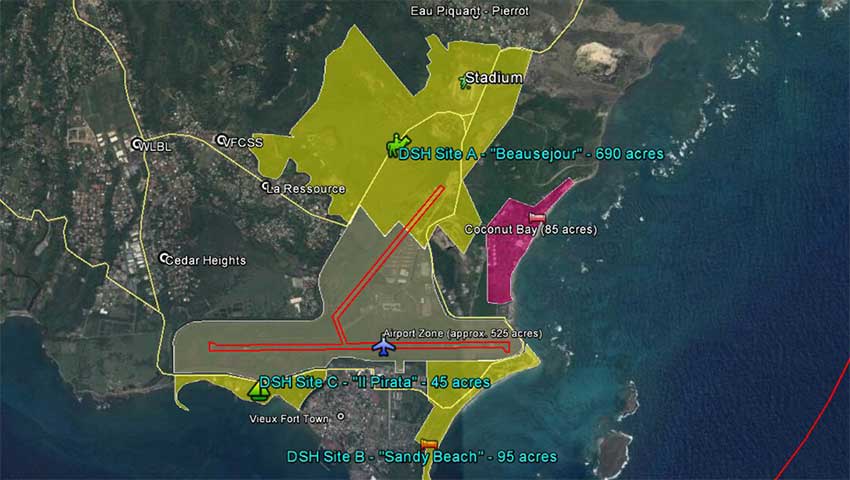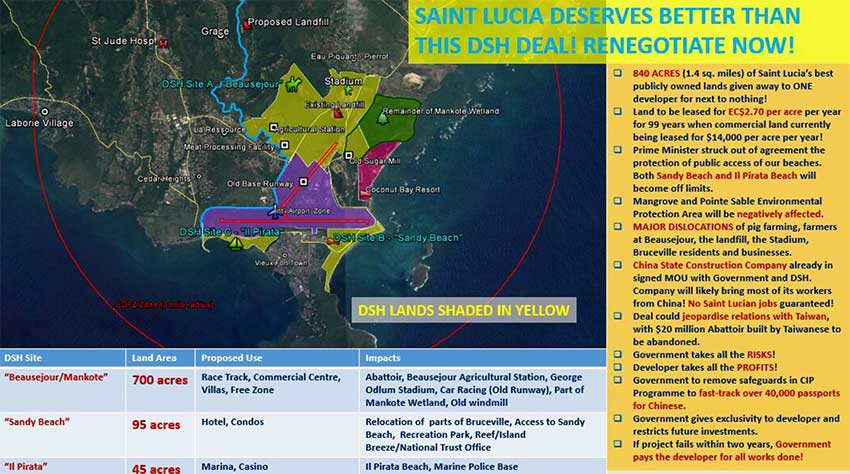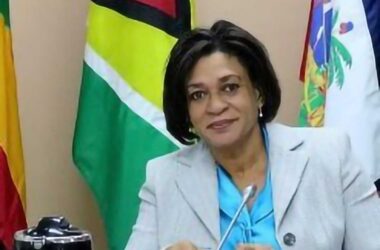THE Vieux-Fort Concerned Citizens Coalition for Change (VFCCCC) did not emerge in response to the DSH project. It came into being many months prior to the publishing of the US$2.6 billion DSH Project headlined in The VOICE of St. Lucia sometime in June 2016 and the circulation of the Framework Agreement and Supplementary Agreement after these were leaked to the public.
The founder-members conceptualized the VFCCCC as a movement to encourage debate and agitate for much-needed change in the Vieux Fort area, particularly with regards to the highly polarized political environment, which almost exclusively determined the quality of representation, quality and pace of local development and level of participation by residents in matters of local and national importance.

The word “citizens” may not have been used properly in this context but that was done deliberately as it was the thinking of the interested parties that this local action could be transformed into a broad national movement that would ultimately move the political spectrum and the strategy of the development process in a new and more progressive direction.
The “leaked” Framework Agreement and Supplementary Agreement covering the DSH Project jolted the VFCCCC into action. The attractive pictures, artistic drawings and accompanying descriptive information which were in the public domain gave the clear indication that this DSH Pearl of the Caribbean is a massive project and its implementation will have enormous economic, social, environmental, developmental and political implications for Vieux Fort and St. Lucia by extension.
The VFCCCC, therefore, scrutinized the pages of the two agreements seeking the assurance that there were sufficient safeguards and opportunities for the government and citizens of the island to benefit enormously from a project of such a scale and diversity. There was also deep concern about protection of the natural environment and its fragile resources.
The signing of this DSH deal took the island by storm but the review of the terms and conditions of the two agreements suggests that not only is the Master Developer a “highly successful Malaysian architect” as we are led to believe; he is also a crafty legal drafter who has boxed this small island into a defenseless corner with probably costly consequences.
The VFCCCC wants to make it abundantly clear that it is not anti-Foreign Direct Investment or anti-DSH. In fact, there has been a constant cry for foreign investments to boost economic development and level of employment in Vieux-Fort and some members of the VFCCCC actively pursued such a course of action but that did not bear fruit. The DSH Proposal has raised some hopes in that regard, but it does not mean that because nothing significant has happened over the years and the people want jobs that the DSH is the instant cure, preferred or exclusive development path of Vieux Fort and the south of the island.
The VFCCCC contends that the DSH deal has too many clauses skewed in favour of the Master Developer while the island takes all the risks, including the buy-back price tag if the project does not produce the desired results after two years. The group has called on the Prime Minister, through letters, a petition and other public statements, to renegotiate the agreements and give Vieux-Fort and St. Lucia a better deal, but to no avail. This call for the renegotiation of the DSH deal is based on the following concerns:
(1) Too much land for one developer
Accessible land is a precious and limited resource in St. Lucia. The Vieux Fort Area is the only place with a significant extent of government and privately-owned lands and such lands should be used wisely and strategically in the development plan of the island. The DSH project will occupy about 900 acres, virtually placing all of the productive and investment lands in Vieux Fort in the hands of one Master Developer for 99 years with the real possibility, as stated in the Framework and Supplementary Agreements, that a significant portion of these lands could be leased at US$1 per acre per year. This will wipe out any possibility for the further development of the town of Vieux Fort and leave no room for alternative or competing developments by other investors, local and foreign. (See photo 1)
(2) There are no apparent significant economic, employment and other benefits that St. Lucia and St. Lucians will realize from this deal.
There is nothing in the Agreements to suggest that Saint Lucia will realize significant financial benefits from this deal, such as profit sharing, revenue from taxation, investment opportunities for nationals. In fact, to accommodate the requirements of the Master Developer, the DSH project will lead to the loss of important national assets in the south of the island, including the National Stadium, the Meat Processing Plant (Abattoir), the Beausejour Agricultural Station and existing infrastructure. The St. Jude Hospital could also be a casualty of the project based on certain pronouncements made by a Minister of Government prior to the unofficial release of the St. Jude Hospital Technical Audit Report, but that is left to be seen. The people of St. Lucia will have to bear the enormous cost of replacing/relocating these facilities.
There is no mention of guaranteed jobs or percentage of jobs reserved for locals during construction and operational phases of the project. If approximate numbers could not be given, then a percentage of nationals to be employed could be written into the Agreement. This absence of an employment quota favourable to the island that is offering so much by way of land, labour and capital, defies comprehension.
There is abundant historical evidence to show that foreign construction companies have brought in their own workforce for projects in St. Lucia. The construction of the George Odlum National Stadium and the Mental Hospital provide two glaring examples. The DSH Agreements widen the environment for the exploitation of cheap labour and the high unemployment rate as nationals will be offered and/or forced to accept low-paid, menial jobs. Bad history is about to be repeated here. This is not good for the island. We must seriously contemplate whether this is the best kind of investment to be encouraged here.
The VFCCCC readily admits with the GOSL that there is an urgent need to develop job opportunities for the residents of Vieux Fort and the south. But it does not understand why recent proposals for job creation submitted to Invest St. Lucia by local prominent businessmen and young, creative entrepreneurs were dismissed so readily e.g. marina, car race track and accompanying development, horse racetrack, riding stables, medium-sized hotels, watersports facilities, etc. With all of the available prime investment lands now under the control of the Master Developer, with zero opportunities for local investment in the DSH project and with no employment guaranteed for locals, it is difficult to show how a cost-benefit analysis of this project will be favourable to the island.

(3) The proposed DSH project will negatively impact traditional livelihoods, small businesses, residential communities and recreational areas in Vieux Fort and beyond.
The VFCCCC and wider Vieux Fort public are unaware of any proposals (preliminary or otherwise) that have been developed and discussed with the thousands of people likely to be directly affected by the DSH project, such as farmers, livestock keepers, beekeepers, fishermen, small-scale business operations, charcoal producers as well as residents of communities. The scale, extent and nature of the project (as illustrated by Phase 1 i.e. the horse racing track and Phase 2 i.e. the Maria Islands Causeway) suggests that there should be significant planning, discussion and negotiation with residents regarding the potential loss of livelihoods, possible dislocation and relocation and consequent compensation packages. In the absence of meaningful engagement with the people of Vieux Fort on the DSH project, there is a mood on the ground that portrays anxiety, worry, uncertainty, nervousness and fear about the future.
Furthermore, the establishment of a three (or five mile?) Equine Disease Free Zone (EDFZ) is a troubling prospect. Within a three-mile radius from the race track (as the crow flies?), this zone will extend all the way to La Ressource, DierreMorne, Cedar Heights, Cantonnement, Augier, Vieux Fort Town, La Retraite, Pierrot, Cannelles and even beyond. This requirement for the DSH project, if implemented, will significantly disrupt, if not eliminate, the traditional way of life of the people. The place of agricultural and animal farms, small business operations and residential communities within and on the periphery of the EDFZ, beg serious and immediate attention.
(4) The DSH deal leaves no land for development and recreation for present and future generations of Vieux Fortians and other St. Lucians.
The DSH project will deprive current and future generations of Vieux Fortians of land for development and recreation, thereby perpetuating the history of dispossession, landlessness and alienation in the Vieux Fort area. The projected population of the district of Vieux Fort by the end of 2017 will be close to 18,000 with over 5,000 people residing in Vieux Fort Town proper. The bulk of the population is concentrated within the 15-50 years age range i.e. about 65% of the population. The population density of Vieux-Fort is calculated at 437 persons per square kilometre, the second highest after Castries. Moreover, World Bank sources indicate that St. Lucia, despite being one of the smallest countries in the world, has a fairly high population density and ranks 41st among the countries of the world. The national population growth rate is steady at 1.2% per year.
Vieux Fort is the only district in St. Lucia with a significant expanse of government-owned (publicly-owned) lands. These lands must be used strategically for the benefit of all St. Lucia. Many residents of Vieux Fort have no choice but to rent land from three major landlords, squat on government-owned lands or buy land out of town from Invest St. Lucia/NDC at EC$10 per square foot. Now under the DSH project, their dream, or their children’s dream, of owning a piece of Fair Helen will simply evaporate under the DSH project with all lands owned by or leased to the Master Developer for 99 years! Moreover, with new foreign landlords surrounding the town of Vieux Fort, it is quite likely that the town will suffocate and eventually succumb to “hidden intentions” of the DSH project.
Therefore, it is extremely important for the VFCCCC to ask: How does the town of Vieux-Fort fit into the DSH project? With no lands remaining in and around Vieux Fort for Vieux Fortians to buy and develop, will they be forced out of their town to make way for development? This scary scenario suggests that the “old” Vieux Fort will simply disappear. This DSH project is a delusion about the development of Vieux Fort. It is a grand scheme designed by an architect to make huge profits for himself by selling our nationality (passports) cheaply, from leasing of our prime investments lands at US$1 per acre per year and the exploitation of our high unemployment rate. The Vieux Fort lands are precious to the development of Vieux-Fort and, by extension, St. Lucia, and if we make the right choices, this will bring invaluable returns for the benefit of all 187,000-plus St. Lucians. The vision for the development of Vieux Fort cannot be projected from the eye lens and graphic impressions or designs of a Malaysian architect.
(5) Anticipated environmental impacts of this massive DSH project on the natural and human environments will be significant, intrusive and long-term.
The initial DSH project concept would have impacted a number of sensitive landscapes, including coastal shoreline, mangrove forests, grazing lands, agricultural lands and the Vieux-Fort River with significant, intrusive and long-term negative environmental consequences. With the unveiling of the Maria Islands Causeway proposed as Phase 2 of the project, the environmental impacts extend into the marine environment with its ecosystems of coral reefs, seagrass beds and off-shore Maria Islands that provide protective habitats for endemic and endangered species of animals and plants. There is no doubt that environmental consequences will be more extensive, significant and irreversible and the prospects of further environmental damage to the local landscape remain frightening as it is not known what the remaining stages of the project will entail.
Therefore, the VFCCCC contends that any decision by the Government of St. Lucia to proceed with any phase/stage of the DSH project must be determined by an environmental impact assessment (EIA). The law of the land must be paramount. Furthermore, given the scale and diversity of the project, an Economic Impact Assessment, as well as a Social Impact Assessment are appropriate preliminary actions before decision-making.
It must be noted here that the impacts of climate change are already quite visible on the beaches within the Pointe Sable Environmental Protection Area (PSEPA). To address this, a project titled “Increasing the resilience to Climate Change and Natural Hazards and reducing the rate of coastal erosion for Pigeon Island National Landmark (PINL) and Pointe Sable Environmental Protection Area (PSEPA) through beach stabilization, Restoration and Enhancement”, is being funded by the German Development Bank in collaboration with the Caribbean Community Climate Change Centre (CCCCC). The project got underway earlier this year. The proposed Maria Islands Causeway places this project in jeopardy. Additionally, the beaches of the PSEPA are highly used as recreational areas by both visitors to and nationals of Saint Lucia and under the DSH project, they are likely to be off-limits to local residents and other citizens of this island.
It must be further noted that the DSH project will bring about significant increase in demands for water, electricity, waste disposal and telecommunications. What will be the economic and environmental cost to the island? Given the current shortcomings of the WASCO water supply to Vieux Fort and other surrounding areas, will the needs of the thoroughbred horses get priority over those of thousands of citizens residing in the south of the island?












